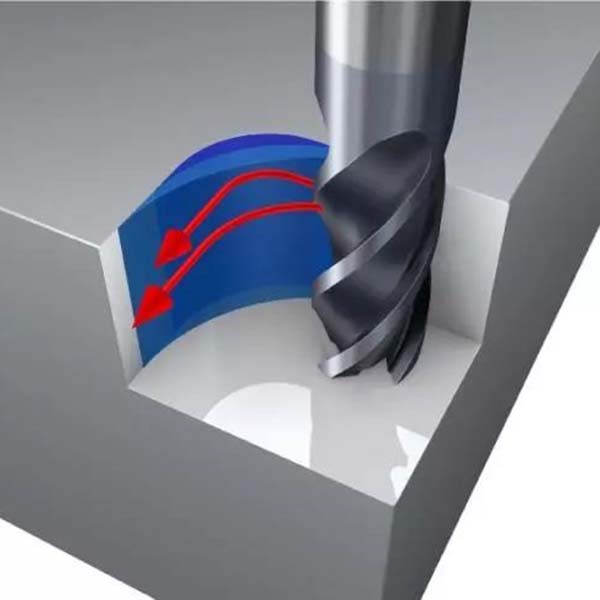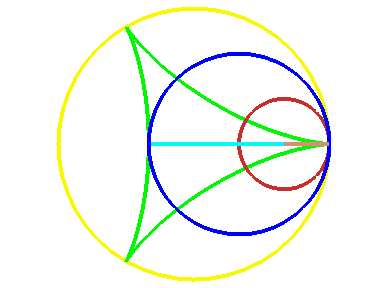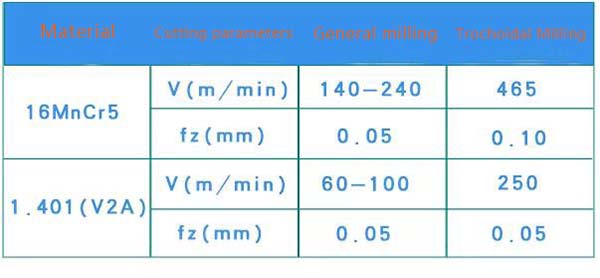What is Trochoidal Milling
End mills are mostly used for machining planes, grooves and complex surfaces. Different from turning, in the processing of grooves and complex surfaces of these parts, the path design and selection of milling are also very important. Like the general method of slot milling, the arc contact angle of simultaneous processing can reach a maximum of 180°, the heat dissipation condition is poor, and the temperature rises sharply during processing. However, if the cutting path is changed so that the milling cutter rotates on one side and revolves on the other, the contact angle and the cutting amount per revolution are reduced, the cutting force and cutting temperature are reduced, and the tool life is prolonged. Thus, cutting can be continued for a long time, such as (Figure 1) is called trochoidal milling.
Its advantage is that it reduces the difficulty of cutting and ensures the quality of processing. Reasonable selection of cutting parameters can improve efficiency and reduce costs, especially when processing difficult-to-machine materials such as heat-resistant alloys and high-hard materials, it can play its role significantly, and It has great development potential, which may be the reason why the industry pays more and more attention to and chooses the trochoidal milling method.
The cycloid is also called the trochoid and the extended epicycloid, that is, the trajectory of a point outside or inside the moving circle when the moving circle extends a certain straight line for rolling without sliding. It can also be called long (short) cycloid. Trochoidal processing is to use an end mill with a diameter smaller than the groove width to process a half-arc groove into a small part of the arc on its side. It can process various grooves and surface cavities. In this way, in theory, an end mill can process grooves and profiles of any size larger than it, and can also process a series of products conveniently.
With the development and application of computer numerical control technology, the controllable milling path, the optimization of cutting parameters, and the multi-faceted potential of trochoidal milling are being used and brought into play more and more. And it has been considered and valued by parts processing industries such as aerospace, transportation equipment and tool and mold manufacturing. Especially in the aerospace industry, commonly used titanium alloy and nickel-based heat-resistant alloy parts have many difficult machining characteristics, including:
High thermal strength and hardness make it difficult for the cutting tool to bear or even deform;
High shear strength makes the blade easy to damage;
Low thermal conductivity makes it difficult for high heat to be exported to the cutting area, where the temperature often exceeds 1000ºC, which aggravates tool wear;
During processing, the material is often welded to the blade, resulting in built-up edge. Poor machined surface quality;
The work hardening phenomenon of nickel-based heat-resistant alloy materials with austenite matrix is serious;
The carbides in the microstructure of nickel-based heat-resistant alloys will cause abrasive wear of the tool;
Titanium alloys have high chemical activity, and chemical reactions can also aggravate damage and so on.
These difficulties can be processed continuously and smoothly with the help of trochoidal milling technology.
Due to the continuous optimization of tool materials, coatings, geometric shapes, and structures, the rapid progress of intelligent control systems, programming technologies, and high-speed, high-efficiency multifunctional machine tools, high-speed (HSC) and high-efficiency (HPC) cutting has also reached a level. new heights. High-speed machining mainly considers the improvement of speed. High-efficiency machining should not only consider the improvement of cutting speed, but also consider the reduction of auxiliary time, rationally configure various cutting parameters and cutting paths, and perform compound machining to reduce processes, improve the metal removal rate per unit time, and at the same time extend tool life and reduce Cost, consider environmental protection.
technology prospect
According to the application data of trochoidal milling in aero-engines (as shown in the table below), when processing titanium alloy Ti6242, the cost of cutting tools per unit volume can be reduced by nearly 50%. Man-hours can be reduced by 63%, the overall demand for tools can be reduced by 72%, and tool costs can be reduced by 61%. The working hours for processing X17CrNi16-2 can be reduced by about 70%. Due to these good experiences and achievements, the advanced trochoidal milling method has been applied to more and more fields, and it has also received attention and started to be applied in some fields of micro-precision machining.
Post time: Feb-22-2023







